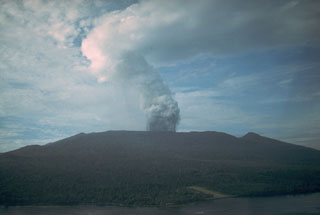Report on Karkar (Papua New Guinea) — July 1981
Scientific Event Alert Network Bulletin, vol. 6, no. 7 (July 1981)
Managing Editor: Lindsay McClelland.
Karkar (Papua New Guinea) New fumaroles and hot springs
Please cite this report as:
Global Volcanism Program, 1981. Report on Karkar (Papua New Guinea) (McClelland, L., ed.). Scientific Event Alert Network Bulletin, 6:7. Smithsonian Institution. https://doi.org/10.5479/si.GVP.SEAN198107-251030
Karkar
Papua New Guinea
4.647°S, 145.976°E; summit elev. 1839 m
All times are local (unless otherwise noted)
"Aerial and ground inspections by volcanologists 18-20 July confirmed local reports that significant development of fumaroles on the W flank of Bagiai Cone has taken place. H2S and SO2 gases were identified in the fumarolic emissions. New hot water springs have been created near Bagiai's summit and on its W flanks. Temperatures in the fumaroles and springs were about 97°C.
"Hydrothermal activity in 1979 Crater has declined. No active mud or water pools were seen in the crater, and only tenuous vapour emission was taking place from sources on the crater floor and walls. Temperatures in fumaroles were about 97°C. Gravity and levelling measurements showed no significant changes. Seismic activity remained steady."
Geological Summary. Karkar is a 19 x 25 km forest-covered island that is truncated by two nested summit calderas. The 5.5 km outer caldera was formed during one or more eruptions, the last of which occurred 9,000 years ago. The steep-walled 300-m-deep, 3.2 km diameter, inner caldera was formed sometime between 1,500 and 800 years ago. Cones are present on the N and S flanks of this basaltic-to-andesitic volcano; a linear array of small cones extends from the northern rim of the outer caldera nearly to the coast. Recorded eruptions date back to 1643 from Bagiai, a pyroclastic cone constructed within the inner caldera, the floor of which is covered by young, mostly unvegetated andesitic lava flows.
Information Contacts: C. McKee, RVO.

